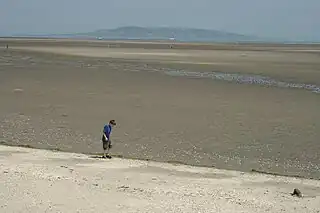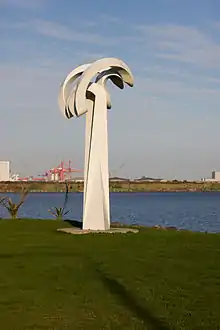Sandymount Strand
Sandymount Strand (Irish: Dumhach Thrá) is a large strand on the east coast of Ireland, adjacent to the village and suburb of Sandymount in Dublin. It is part of South Bull - a major component of the south side of Dublin Bay, and part of the Dublin Bay Biosphere Reserve. South Bull is a mirror to the North Bull sandbank, which grew into North Bull Island.
| Designations | |
|---|---|
| Official name | Sandymount Strand/Tolka Estuary |
| Designated | 7 June 1996 |
| Reference no. | 832[1] |

Sandymount Strand is a popular place for locals to take a walk. People, and in the past - there is no longer public vehicular access - cars, have been occasionally trapped by the incoming tide. A large inlet of water that remains even at low tide is known locally as "Cockle Lake".
History
In the 1930s, the strand was included as a suggested location for the construction of a new Dublin airport.[2]
The baths

The Merrion Promenade Pier and Baths Co built Sandymount swimming baths in 1883. The baths measured approximately 40 by 40 metres, with a 75-metre pier added in 1884. The pier featured a bandstand halfway along it and summer concerts were regularly held there for many years. By 1920, the pier had deteriorated so much that it had to be demolished. The concrete baths section, which resembles a small harbour, remains.
Martello Tower
About halfway along the strand is a Martello tower. Built in 1804, it is one of many such circular defensive watchtowers along the coastlines of the British Isles, as part of a system of defences[3] to provide advance warning of a feared invasion by Napoleon. The Martello Tower at Sandymount is the setting for the opening scene in James Joyce's 1922 novel Ulysses. The Tower was used by the Dublin United Tramways Company as an office,[4] and was also a popular cafe back in the 1960s. An attempt to turn the tower into a restaurant led to the installation of a large window with roller blinds on the seaward side of the tower. The restaurant never opened, leaving the tower with the modified window.

Awaiting the Mariner (An Cailín Bán)
At the end of the strand walkway lies a 20-foot high metal sculpture donated by Mexican President Vicente Fox in November 2002, symbolizing the friendship between the Irish and Mexican people. This work, named Awaiting the Mariner, was created by Mexican sculptor Sebastián and was the first permanent work by a Mexican artist in Dublin. There was a mixed reaction from residents when the sculpture was originally placed.[5]
Gallan Gréine
The Gallan Gréine marker stone is located at the end of the strand beside the Irishtown playing fields. Carved by Cliodna Cussen and dedicated to James Joyce in 1983, a sighting stone stands 300 metres to the west and when aligned with the marker stone to the east, indicates the winter solstice with the sun rising over Killiney Hill around 21 December each year. The face of this stone is also a sundial.[6][7]
In fiction
"Am I walking into eternity along Sandymount strand?"
– James Joyce, Episode 3 of Ulysses
James Joyce based two episodes of his 1922 novel Ulysses along Sandymount Strand. In the third episode, "Proteus", Stephen Dedalus wanders the strand, while later the same day, in the "Nausicaa" episode, Leopold Bloom sits on a rock and masturbates as he watches a young woman sunbathing.
References
- "Sandymount Strand/Tolka Estuary". Ramsar Sites Information Service. Retrieved 25 April 2018.
- McAteer, Desmond (1935). "Suggested Airport for Dublin". Studies: An Irish Quarterly Review. 24 93: 73–84 – via www.jstor.org/stable/30097160.
- Clements, Bill (2011). Martello Towers Worldwide. Pen and Sword. p. 214. ISBN 978-1-8488-4535-0.
- "The Martello Tower in Sandymount". Dublin City Council. Retrieved 16 March 2017.
- "Sculpture on Sandymount strand creates shock waves". 6 November 2002. Retrieved 15 March 2017.
- "Sandymount Walking Trail Map & Guide", Dublin City Council, 2015, retrieved 17 March 2017,
The Gallan Gréine marker stone was carved by Cliodna Cussen and dedicated to James Joyce in 1983 [..] The face of this stone is also a sundial
- Leeza Kane (30 December 2013), "D4 Local Sculpture Explained", Four News, retrieved 17 March 2017